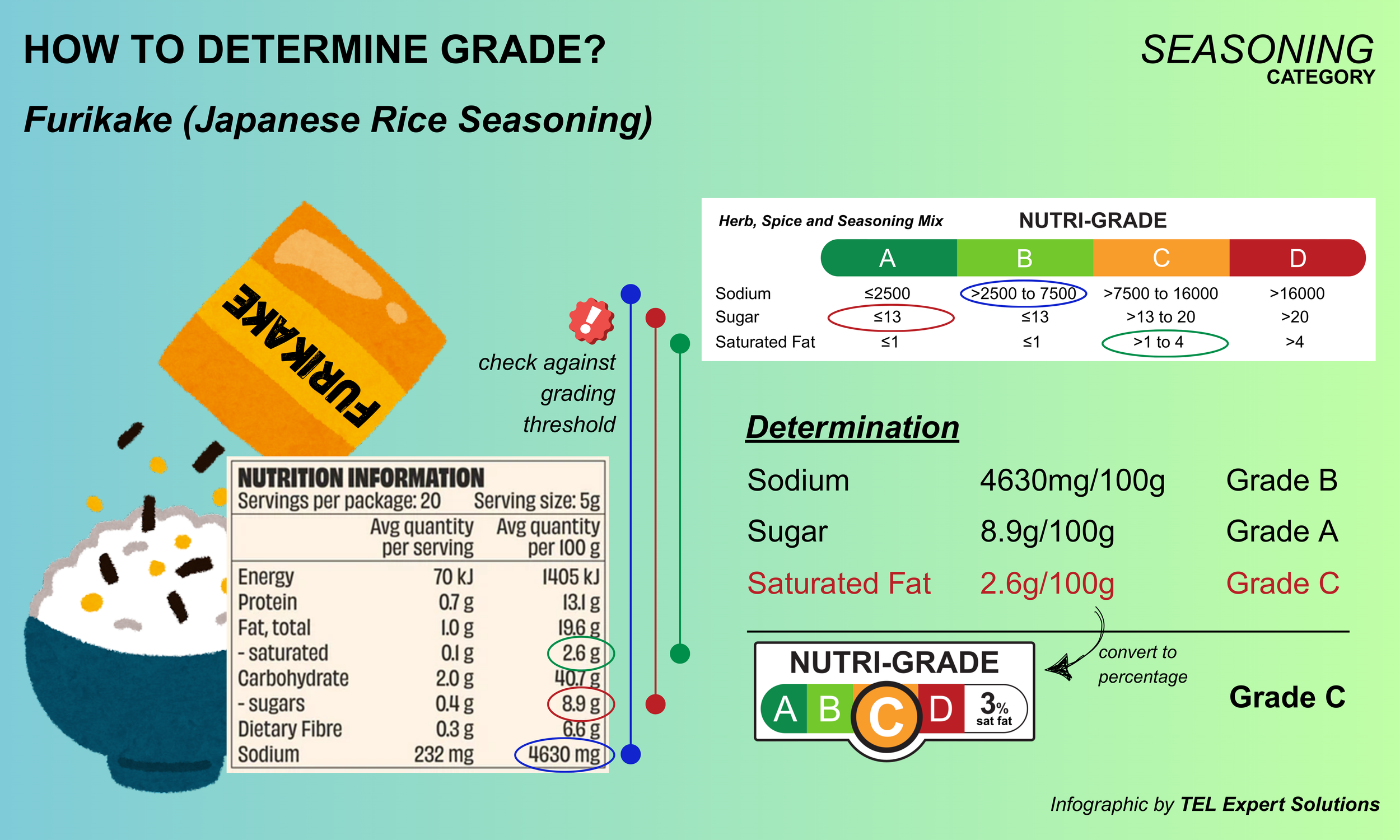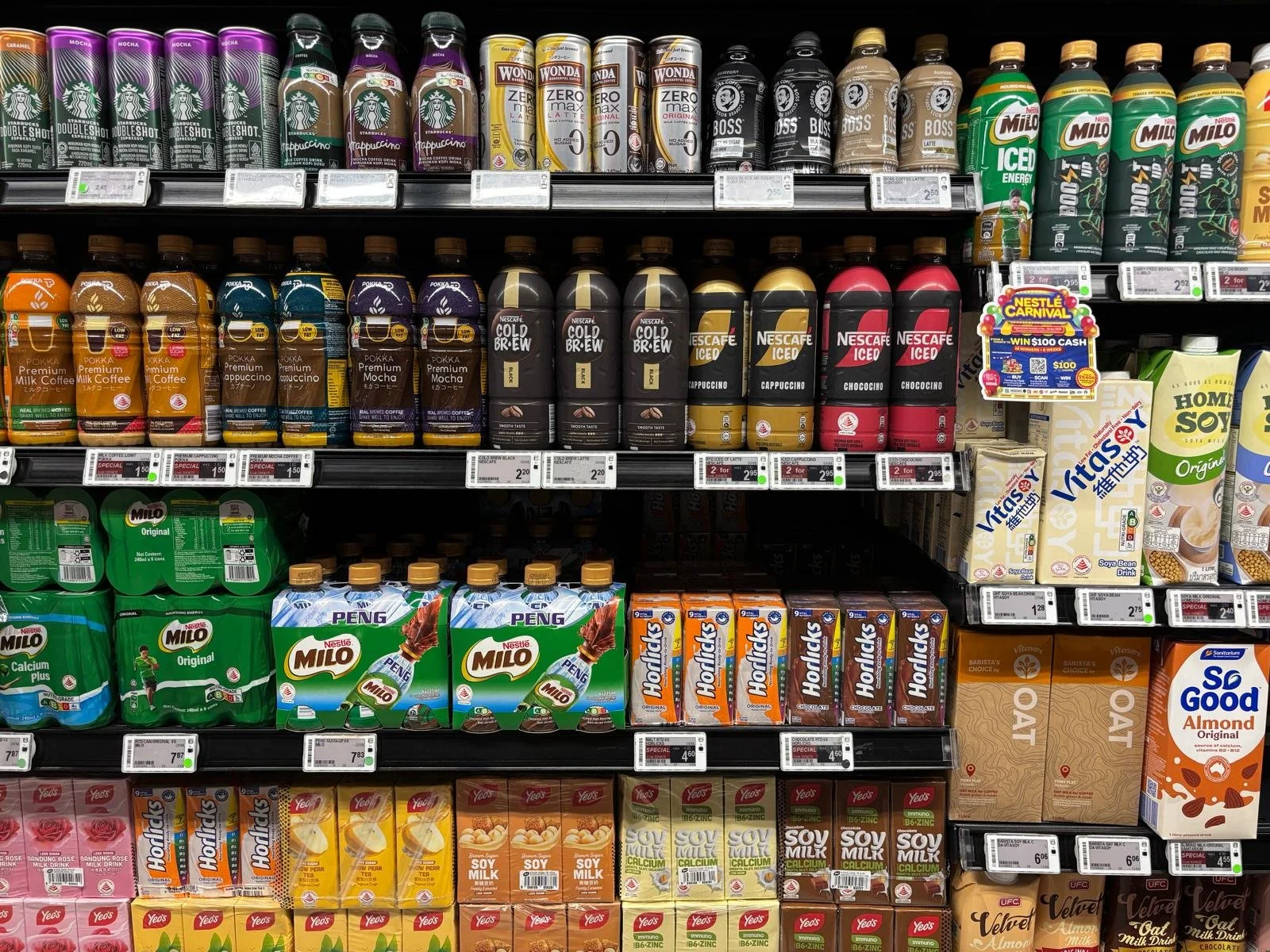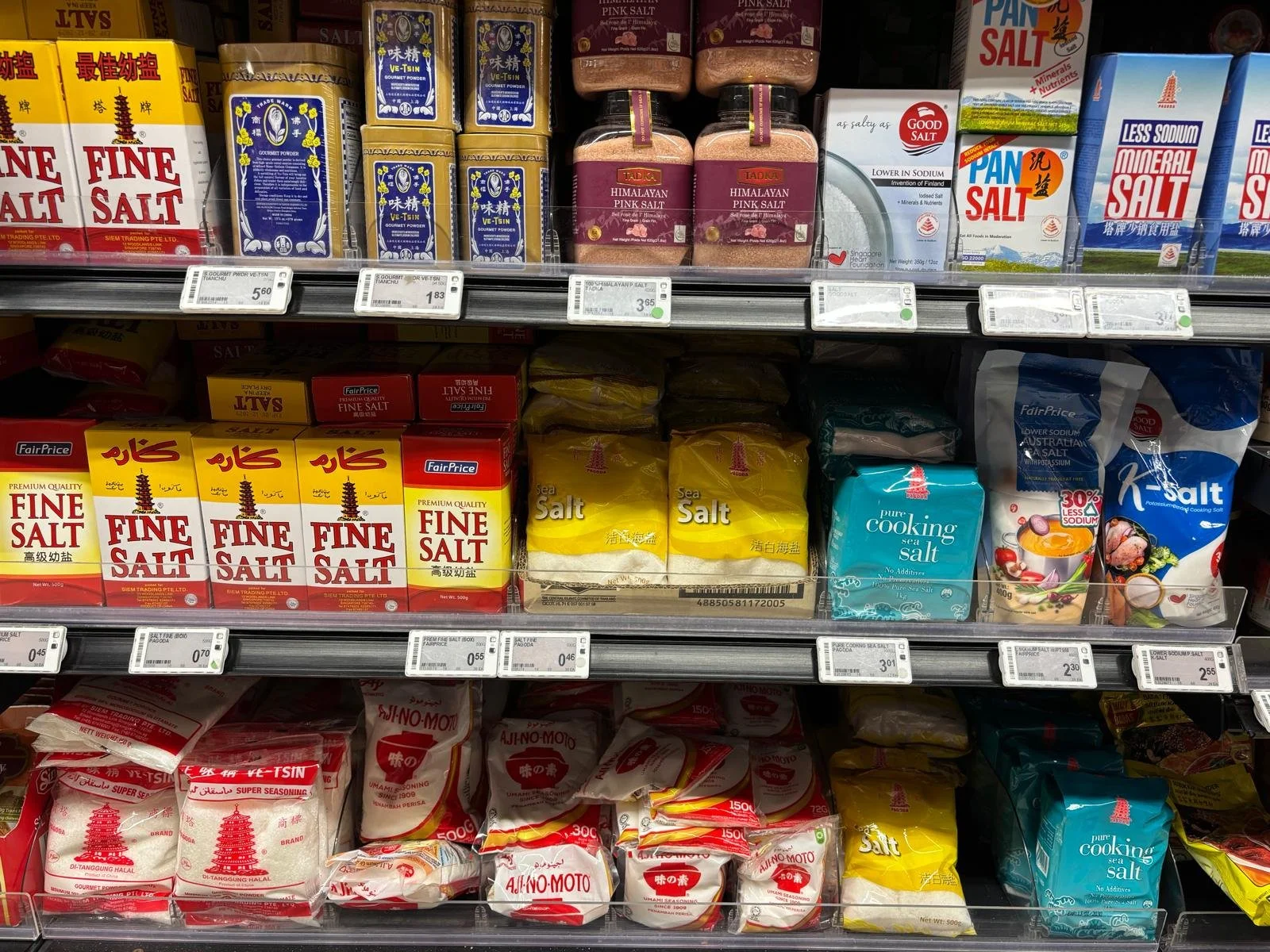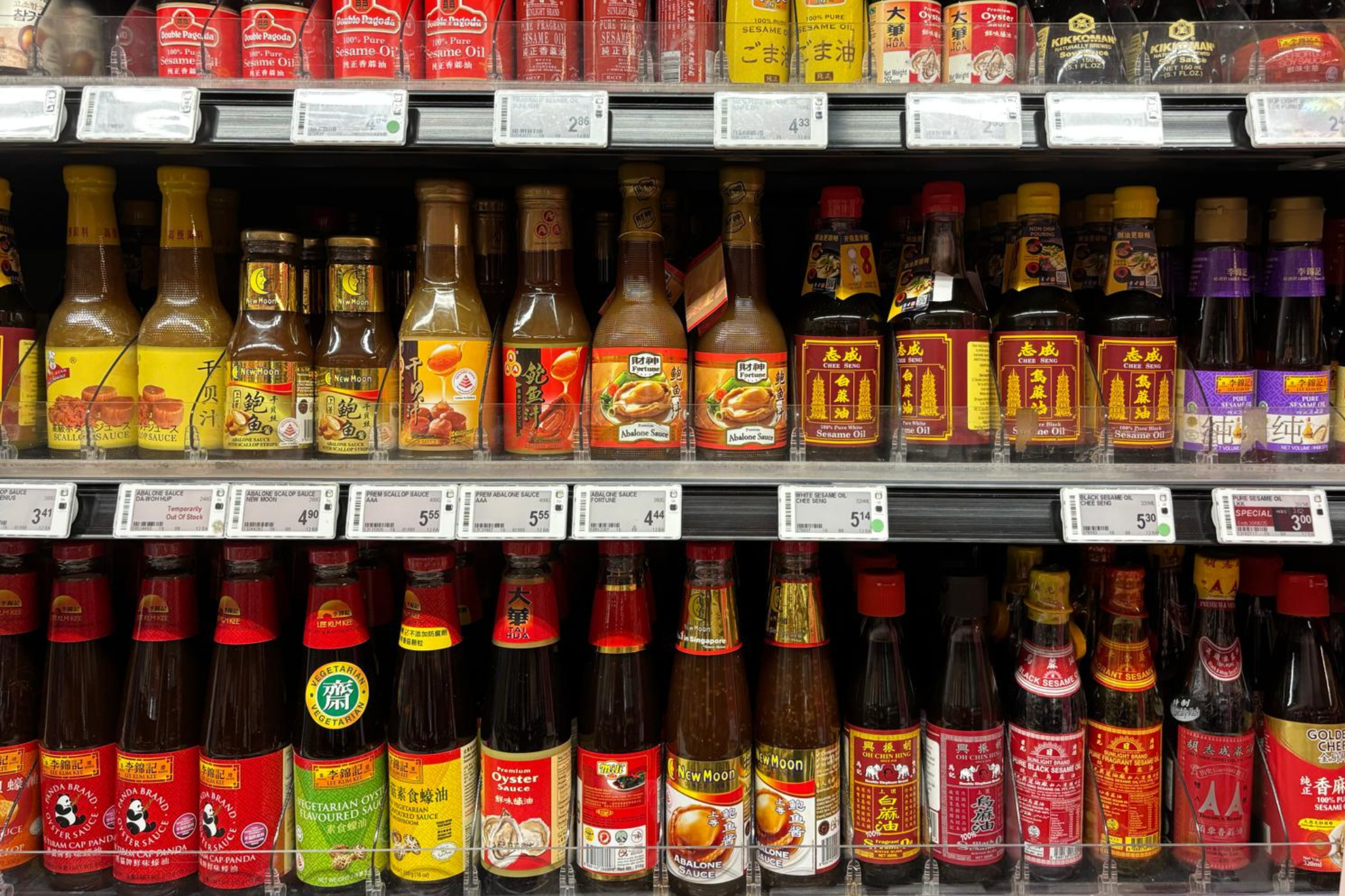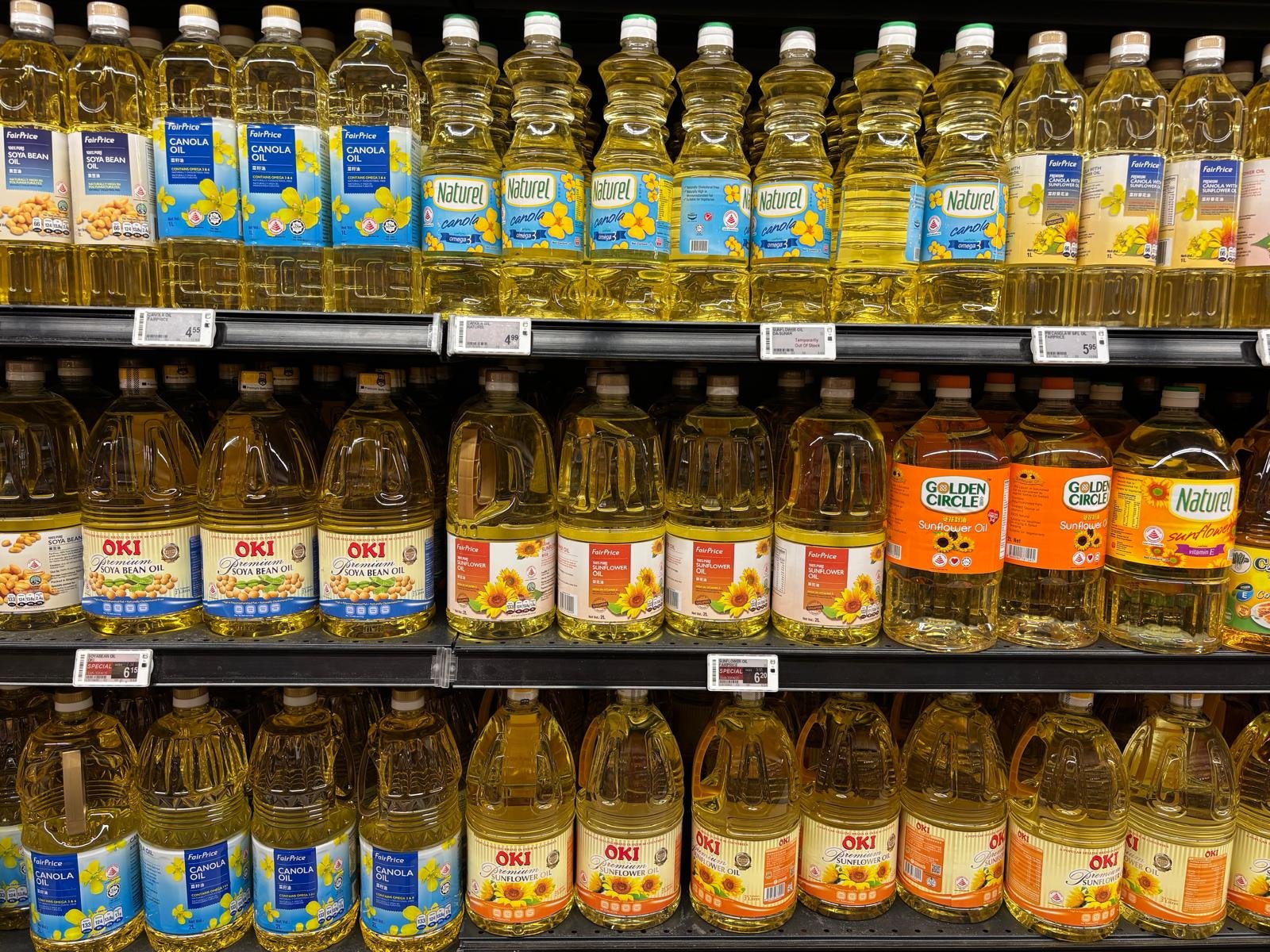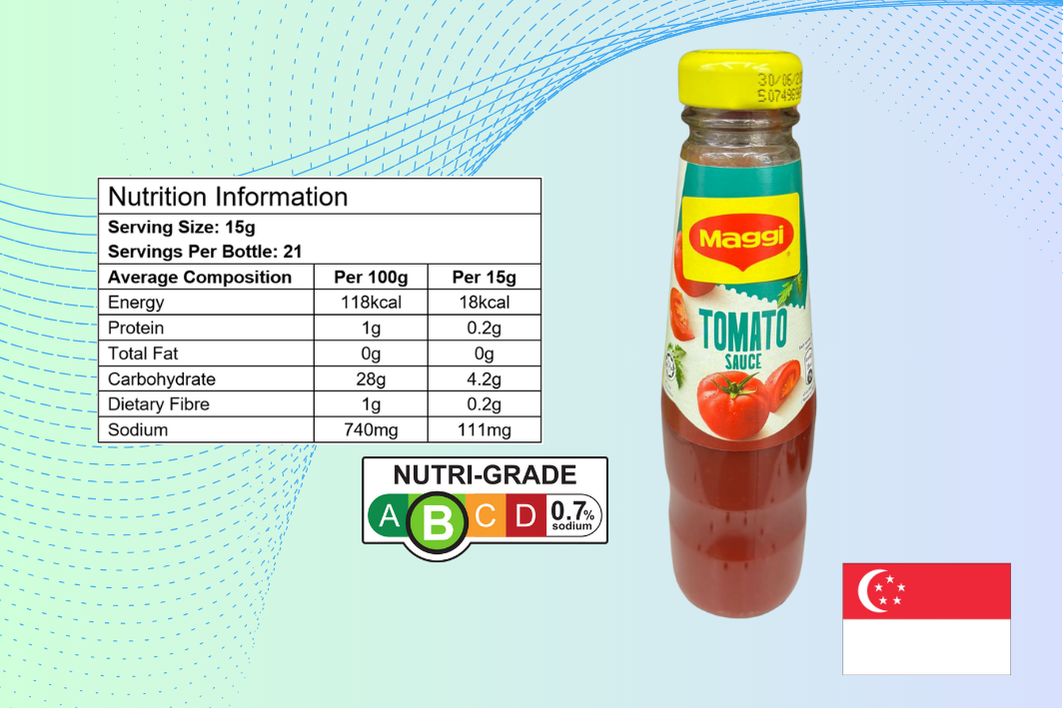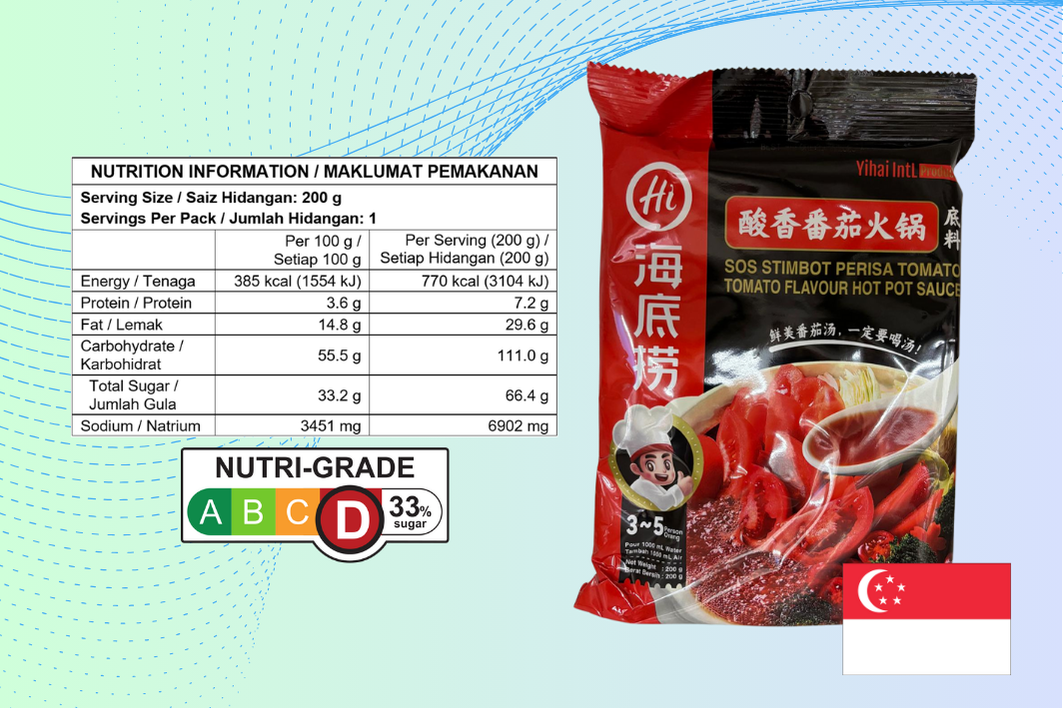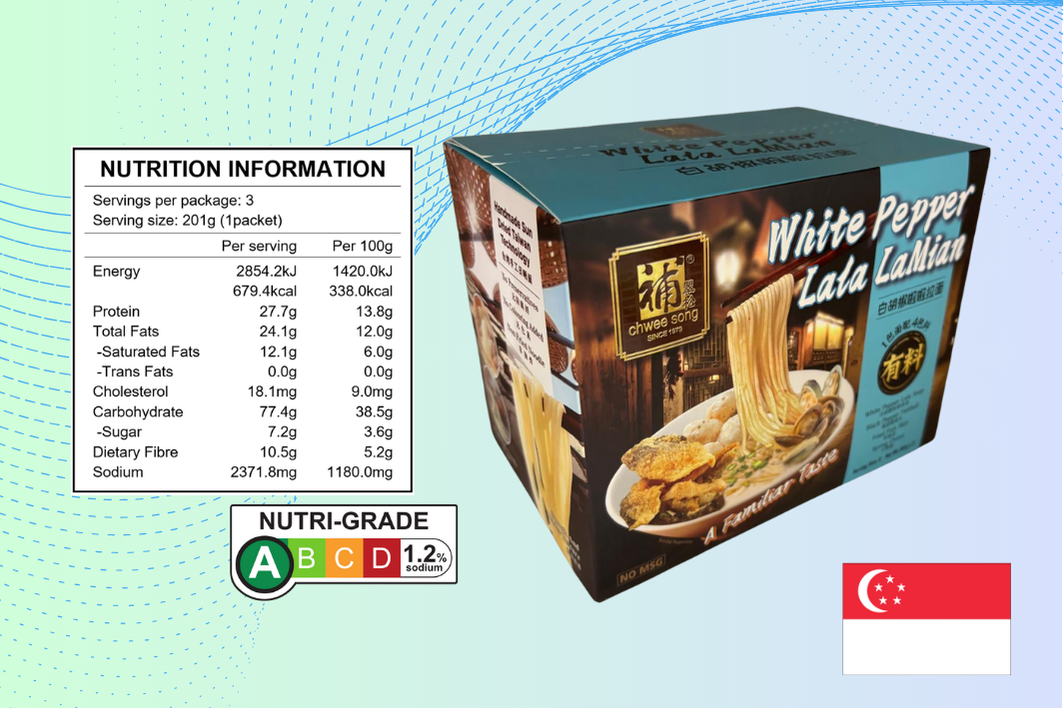
FOOD
The information below outlines the revised Nutri-Grade labelling requirements proposed to take effect from mid-2027. Please note that these regulations are subject to change. We recommend checking back regularly for the latest updates (last updated on 25 Apr 2025). To view the current Nutri-Grade regulations for beverages, please click HERE.
TEL EXPERT SOLUTIONS | Managed by Experts. Overseen by Experts.
Nutri-Grade Labelling (Revised)
Nutri-Grade is a nutrition labelling system introduced in Singapore to help the public make informed choices by highlighting nutrients of concern - sugar and saturated fat - in beverage products, as part of the nation's efforts to combat diabetes. The system uses a colour-coded grading scale from Grade A (green), representing the lowest levels of sugar and saturated fat, to Grade D (red), indicating the highest levels. It is mandatory for all beverages, whether pre-packaged or freshly prepared, with Grade C and D drinks required to display the Nutri-Grade mark clearly on product packaging, menus and menu boards.
From mid-2027, the Nutri-Grade system will be extended to cover pre-packaged cooking oils, salt products, sauces, pastes, seasonings, soups, broths and instant noodles, in response to increasing rates of hypertension and high blood cholesterol in Singapore. A new nutrient of concern - sodium - will also be introduced. The mark will maintain its visual structure, with the key difference being the nutrient of greatest concern being displayed instead of sugar.
WHAT IS NUTRI-GRADE?
Nutri-Grade is a mandatory labelling system in Singapore that encourages the development of healthier options for selected food and beverages, while helping consumers make more informed choices. It provides clear, front-of-pack information on the levels of key nutrients of concern.
Nutrients of Concern
Sugar
Saturated Fat
Sodium (effective mid-2027)
Under this system, relevant products must display the Nutri-Grade Mark, which reflects the product’s grade based on its nutritional content.
Pre-packaged products must show the Nutri-Grade Mark prominently on the front of the packaging. They are also required to carry nutrition labels listing minimally the mandatory nutrients and the nutrients of concern.
Beverages sold at selected food and beverage outlets must display the grade clearly on menus and menu boards.
For freshly prepared beverages, the Nutri-Grade requirements extends to beverage toppings that includes, but are not limited to, tapioca pearls, ice cream, whipped cream, nata de coco, grass jelly and pudding. The supplementary Sugar Declaration Mark must be prominently displayed on all menus, menu boards and point-of-sale materials.
The Nutri-Grade system classifies products into four grades:
Grade A – Lowest levels of nutrients of concern
Grade B
Grade C
Grade D – Highest levels of nutrients of concern
Products that receive a Grade C or D are required to display the Nutri-Grade label prominently on the front of the packaging. Furthermore, products of grade D are subject to advertising restrictions.
HOW DOES THE NUTRI-GRADE SYSTEM WORK?
Revised Nutri-Grade (effective mid-2027)
Each nutrient of concern is individually graded, and the overall grade assigned to the food or beverage shall be based on the lowest grade among them. In the case of two or more nutrients receiving the same lowest grade, the nutrient to be displayed on the Nutri-Grade mark will follow a set priority order: sodium first, followed by sugar, then saturated fat.
Below are the required nutrients of concern for food and beverage products covered under the Nutri-Grade mandate.
HOW DO I GET THE VALUES FOR NUTRIENTS OF CONCERN?
There are three accepted methods for determining the values of nutrients of concern, each with its own advantages and limitations: (1) Laboratory Testing, (2) Nutritional Calculations, and (3) Averaging Values from Similar Foods.
While only the value for the key nutrient of concern is displayed on the Nutri-Grade Mark, pre-packaged products bearing the mark must also include a nutrition label that complies with the mandatory requirements under the Food Regulations.
HOW TO DISPLAY THE NUTRI-GRADE MARK ON MY PRODUCT OR MENU?
On Product Packaging
The horizontal variant of the Nutri-Grade Mark should be used by default, unless the vertical variant is more suitable due to packaging limitations.
These includes, but are not limited to:
Limited horizontal space on the packaging that prevents the horizontal mark from meeting minimum size and clear space requirements.
Busy or cluttered backgrounds on the packaging, where the vertical mark offers better legibility.
The use of Simplified Nutri-Grade Marks is not permitted on product packaging, except for the opaque outer packaging of multipacks that contain more than one product type.
On Menus, Menu Boards and Beverage Dispensers
When multiple beverage options are listed on menus, menu boards, or beverage dispensers, Simplified Nutri-Grade Marks are allowed. However, the colour-coded scale must also be clearly visible, along with a statement explaining the basis of grading.
Examples of accepted statements include, but not limited to:
Nutri-Grade is based on preparation at 120% sugar (before addition of ice).
Nutri-Grade is based on default preparation (before addition of ice).
Nutri-Grade is based on default preparation.
If only one item is displayed per menu page, board or dispenser, the horizontal variant of the Nutri-Grade Mark must be used as the default.
On E-Commerce Platforms or Websites
When products are displayed individually i.e. in thumbnails, pictorial cards, sales page, advertising page, etc., the horizontal variant of the Nutri-Grade Mark should be used by default.
In the case of multiple products being shown on the same page, Simplified Nutri-Grade Marks may be used. Please note that the colour-coded scale must also be prominently displayed within the same page.
HOW LARGE SHOULD THE NUTRI-GRADE MARK BE?
A general formula applies when determining the appropriate size of the Nutri-Grade Mark on product packaging:
Length of the longer side of mark = (H+W) / 7
The actual size of the mark must be equal to or larger than the value calculated using this formula.
For scaled product images used in advertising or displayed on menus, the mark should be resized proportionally to match the image size, using the same formula.
To ensure legibility, the Nutri-Grade Mark must never be smaller than the following dimensions:
Horizontal variant : 19.8 mm (W) × 8.5 mm (H)
Vertical variant : 8.5 mm (W) × 19.8 mm (H)
Simplified Nutri-Grade mark : 19.8 mm (W) × 8.5 mm (H)
FAQs
Nutri-Grade on Beverages
-
Small food businesses that sell or supply freshly prepared Nutri-Grade beverages may be exempt from certain requirements if they (i) earn no more than S$1 million in revenue in the latest financial year, and (ii) operate at fewer than 10 food premises. However, they must still comply with regulations for pre-packaged Nutri-Grade beverages and non-customisable drinks dispensed from vending machines or automated beverage dispensers.
-
Drinks sold by home-based businesses are exempt from this regulation if they meet the following criteria for freshly brewed beverages: (i) earn no more than S$1 million in revenue in the latest financial year, and (ii) operate at fewer than 10 food premises.
-
Yes, for beverages, nutritional values used for Nutri-Grading can be obtained through calculation methods.
-
Yes, under Regulation 184A, beverages formulated for special medical purposes and labeled for use under medical supervision, as well as alcoholic beverages containing more than 0.5% alcohol by volume at 20°C, are exempt from the Nutri-Grade regulations.
-
It is sufficient only for pre-packaged beverages with a total surface area smaller than 100 cm². Under Regulation 184C(6)(a), which took effect in December 2022, pre-packaged beverages with a total surface area smaller than 100 cm² are exempt from displaying a full Nutrition Information Panel (NIP), provided the label includes the quantities of total sugar and saturated fat. There is no prescribed format or placement required for this declaration on the packaging.
-
You may find more information at www.telexpertsolutions.com/food/nutri-grade-information
-
Yes, there are. Please refer to the section above titled “How to display a Nutri-Grade mark on my product or menu” for reference.
-
It is mandatory for beverages with Grades C and D to display the Nutri-Grade mark, while those with Grades A and B are optional. In addition, beverages with a Grade D rating are not allowed to be advertised.
-
As of 2025, the Nutri-Grade mark is a labelling scheme for drinks and is based on sugar and saturated fat content.
The Healthier Choice Symbol (HCS) and Healthier Dining Programme (HDP) labels are voluntary and apply for both food and drinks.The HCS and HDP guidelines are aligned with the Nutri-Grade grading system. Drinks that are graded A or B may carry both the healthier choice identifier and the Nutri-Grade mark, just one of them or neither. Both these initiatives coexist to help guide consumers in making informed drink choices easily.
-
Non-compliance with the measures will be an offence punishable upon conviction with a fine not exceeding $1,000; and in the case of a second or subsequent conviction, a fine not exceeding $2,000.
Nutri-Grade on Salt, Sauce and Paste, Seasoning, Instant Noodle and Oil
-
Nutri-Grade measures is mandatory. It aims to reduce public sodium and saturated fat intake, and address the growing public health concerns with hypertension and hyperlipidaemia.
-
Food products in the categories of salt and salt substitutes, sauces and pastes, seasonings, instant noodles (both dry and with soup), and oils and oil substitutes.
-
The amount of sodium, sugar and saturated fats are used to determine the Nutri-Grade rating. You may visit Nutri-Grade Information page to find out more.
-
The revised Nutri-Grade regulation applies only to certain categories of pre-packaged food products, such as salt, sauces and pastes, seasonings, instant noodles, and oils. Ready-to-eat food products are currently not included under this regulation.
-
The Nutri-Grade extension applies to pre-packed products intended for sale or provision in the following contexts:
a) By retail food businesses;
b) From vending machines;
c) As part of a contract involving accommodation, services, or entertainment;
d) When providing services to patients, children in custody, or inmates;
e) As part of amenities provided at workplaces (e.g., office pantries).Under point (a), this includes pre-packed products sold in various retail outlets such as supermarkets (both physical and online) or at F&B establishments (e.g., restaurants selling pre-packed bottles of sauce).
The following products are exempt from the Nutri-Grade extension (this list is non-exhaustive):
i. Business-to-business packaging (e.g., cartons for transporting products);
ii. Pre-packed products intended for use by F&B establishments in dish preparation;
iii. Non-pre-packed products, such as salt shakers and open sauce bottles, offered by F&B establishments or retail food outlets for use within the premises. -
Bottled Shallots or Raw/Fried Garlic
These are considered packed forms of vegetables and therefore fall outside the scope of salt, sauces and seasonings, instant noodles, and oil.Canned or Chilled Soup (Ready-to-Serve)
As ready-to-serve meals that often contain vegetables or meat, these are classified as convenience meals and are not covered by the Nutri-Grade extension.Cooking Kits with Sauce/Seasoning Packs (Plus Other Ingredients Like Noodles or Rice)
These are treated as processed foods and not individually as sauces or seasonings, hence excluded.Confectionery Products
These fall under a different food category and are not included in the Nutri-Grade scope.Dips (e.g., Guacamole, Hummus)
Being ready-to-serve, these products are excluded from the Nutri-Grade extension for sauces and seasonings.Fresh Herbs
These are actual plant ingredients and are not considered prepacked food products.Honey
Honey is not part of the "sauces and seasonings" category and is not a key source of sodium, hence excluded.Noodle Snacks
These are processed foods and are not classified under instant noodles or sauces/seasonings for Nutri-Grade purposes.Powders That Are Not Herbs or Spices (e.g., Peanut Powder)
These do not fall under the seasoning or spice categories.Processed Meat or Seafood Products or Convenience Meals with Sauce/Seasoning Packs
These are considered ready-to-eat foods or meal kits, thus excluded from the Nutri-Grade extension.Spices Packed Upon Customer Request
As these are not prepacked, they are not covered by Nutri-Grade requirements.Vinegar and Cooking Wine
These do not fall within the scope of sauces and seasonings, and are not key sodium sources according to global sodium benchmarks.
-
Small single-serve packages with a total packaging volume of less than 30 cubic centimetres are exempt from the Nutri-Grade measures.
-
You may find more information at www.telexpertsolutions.com/food/nutri-grade-information
-
HPB has not confirmed the sizing requirements for food products. However, you may refer to the section above titled “How to display a Nutri-Grade mark on my product or menu” for reference sizing. Please note that sizing requirements may vary.
-
The Nutri-Grade extension is expected to come into effect by mid-2027, after which no grace period will be provided by the government.
LET US SUPPORT YOU
The Nutri-Grade labelling system may look simple, but applying it correctly can be complex. With so many products requiring grading, why not leave the heavy lifting to us? Whether you're an importer, trader, distributor, manufacturer, F&B business owner or food entrepreneur, we provide expert support to ensure your Nutri-Grade Marks are accurate, compliant, and ready for use. From precise laboratory testing for detailed nutrient profiling to cost-effective nutritional calculations based on your recipes and formulations, we offer flexible solutions to suit your needs and budget. Partner with us to simplify the process today and bring your products to the masses with confidence!
SERVICES AND PRICING STRUCTURE
We understand that unexpected costs can be frustrating. That's why we believe in complete transparency and ensuring you know exactly what to expect, with no hidden fees.
OPTIONAL ADD-ON SERVICES
Generation of Nutrition Information Panel or Nutrition Facts Label
by Calculation: From SGD 140 per product (inclusive of 9% GST)
by Food Testing: From SGD 200 per product (inclusive of 9% GST)
Provision of Digital Format for Front-of-Pack Label
Delivery of file (in SVG, PDF, or PNG format) containing the front-of-pack label with the relevant figures.
SGD 10 per label per product (inclusive of 9% GST)
PRINT SERVICES
in collaboration with
Expert Stickers
Nutri-Grade Mark Stickers
for affixation over existing product label
Vertical & Horizontal Variants
25 x 11 mm, 102 pcs - SGD 2.50 per set (inclusive of 9% GST)
19 x 10 mm, 152 pcs - SGD 2.50 per set (inclusive of 9% GST)
13 x 7 mm, 242 pcs - SGD 2.50 per set (inclusive of 9% GST)
Customised Size and Quantity - Contact Us
Simplified Variant
19 x 10 mm, 152 pcs - SGD 2.50 per set (inclusive of 9% GST)
Customised Size and Quantity - Contact Us
Suger Declaration for Topping Mark
13 x 7 mm, 242 pcs - SGD 2.50 per set (inclusive of 9% GST)
Customised Size and Quantity - Contact Us
Notes to Print Services
[1] Order Specifications : For all orders, please specify the variant (if applicable), quantity and sticker size required. For Nutri-Grade stickers, indicate the grade and the corresponding levels of nutrients of concern (i.e. 2% sugar, 15% sat fat, 4% sodium, etc.). For Healthier Choice Symbol (HCS) stickers, please specify the statement to appear beneath the logo (i.e. Higher in Calcium, Lower in Saturated Fat, No Added Sugar, etc.).
[2] Design Submission : For any customised requests, please send us your design in PNG, JPEG, or SVG format.
[3] Tolerance Allowance : Please allow an error of ±2 mm for all prints.
[4] Custom Sizes : If you require stickers or labels of other sizes, please enquire with us.
ENQUIRE TODAY
Let us support you if have any queries or has interest in any of our services.











